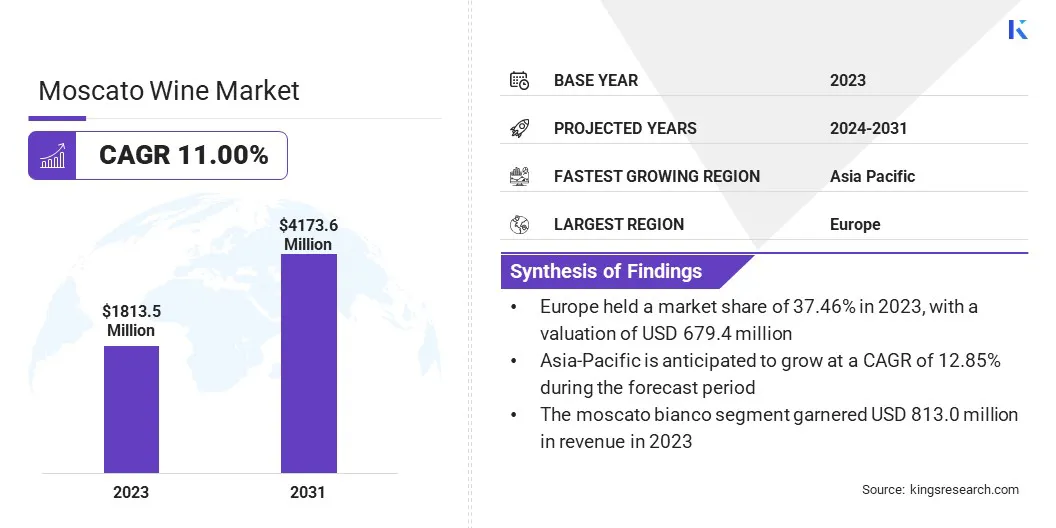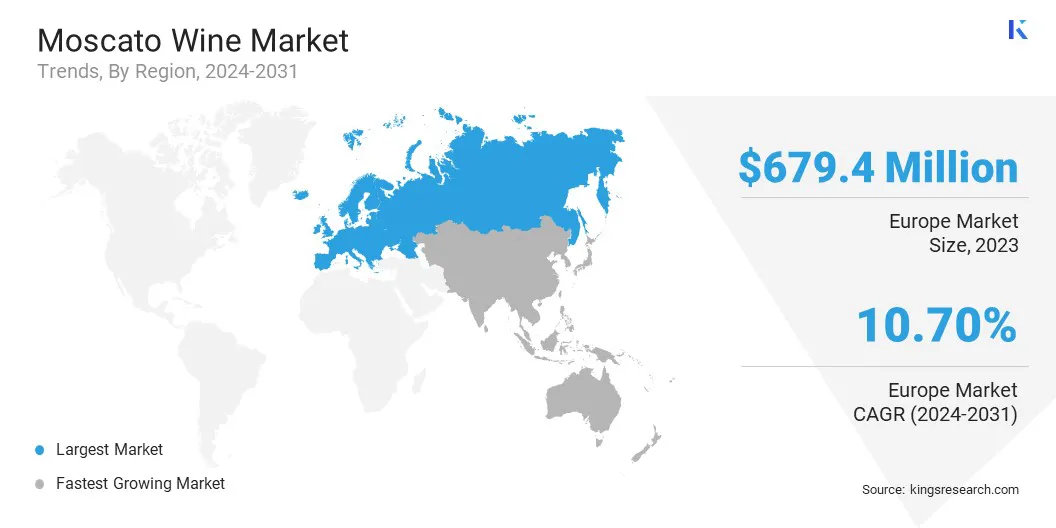Moscato Wine Market Size
The global Moscato Wine Market size generated revenue of USD 1,813.5 million in 2023 and is estimated to reach USD 4,173.6 million by 2031, progressing at a CAGR of 11.0% from 2024 to 2031. The global moscato wine industry is expanding at a significant rate due to increasing disposable incomes, evolving consumer preferences, and a rising culture of wine appreciation. In the scope of work, the report includes products offered by companies such as Sula Vineyards, Stella Rosa, Barefoot Cellars, Castello del Poggio, Bartenura, Riunite, Jacob's Creek, Roscato, Paolo Saracco, Yellow Tail, and others.
Moreover, an upward trend among consumers showing a strong preference for premium wine products has positively impacted the moscato wine market. One of the major factors supporting the market growth is rising consumption of organic wine and a strong preference for sweet wines in North America and Europe. With growing health concerns across the globe, consumers have significantly shifted to low-alcoholic beverages and are exploring different wine options, which is likely to further support market growth.
Moscato manufacturers are increasingly adopting artisanal production methods and developing innovative products to cater to the rising demand for exclusivity. Moreover, the distinguishing attributes of moscato, along with strategic marketing, culinary versatility, and economic prosperity, have positioned it as a premium choice in the evolving dynamics of wine.

Analyst’s Review
The global moscato wine market is anticipated to experience significant growth over the forecast period. This growth can be attributed to several factors, including the increasing demand for flavored wines, the versatility of moscato for pairing with various foods, and widespread availability in liquor stores. Additionally, moscato has garnered immense popularity among younger wine consumers due to its sweeter taste and vibrant characteristics. Moreover, the growing trend of wine tourism presents opportunities for moscato producers to showcase their products and attract new customers.
Market Definition
Moscato wine, originating from the muscat grape variety, is a delightful and aromatic white wine known for its distinctively sweet and fruity characteristics. The word moscato refers to a family of grape varieties within the broader Muscat family, each contributing to the production of unique and flavorful wines.
Commercially available types of moscato wine include moscato bianco, moscato rosa, moscato giallo, and others. These variants are widely accessible through various retail outlets, including liquor stores, specialty stores, hypermarkets, and other retail formats. With its widespread availability across different retail channels, moscato wine continues to cater to a diverse consumer base, further contributing to its popularity and market growth.
Market Dynamics
The mounting popularity of moscato wine among millennials can be attributed to several key factors, reflecting shifting preferences and cultural trends within the demographic. Rising demand for dessert wines such as port, sherry, and moscato among millennials is a key factor supporting market growth. This trend is further fueled by the development of innovative flavors by manufacturers to capitalize on the surging global demand for moscato wines. The efforts undertaken by wine producers to innovate and directly target millennials through marketing strategies have significantly contributed to the increasing popularity of moscato wine across the globe. Companies are prioritizing innovative packaging and introducing canned moscato wines to offer a convenient option for modern consumers.
Furthermore, moscato wine manufacturers are utilizing modern fermentation techniques to retain the natural attributes of grapes in the final product. This modern fermentation technique focuses on producing quality wine and meeting the growing demand for natural products worldwide. Moreover, the increasing preference for organic products among millennials is another significant factor driving market growth. Companies are focusing on acquiring organic certifications and adhering to stringent industry regulations to produce quality moscato wines that are likely to expand market growth over the forecast period.
One of the key opportunities driving moscato wine market development is the rising demand for sparkling wine across the globe. A gradual consumer shift toward wines with higher acidity and lower alcohol content is emerging as a major factor augmenting the demand for sparkling wine. Moreover, expanding fine-dine restaurants, and the growing preference for premium luxury products have increased the global demand for innovative sparkling wines. This robust demand offers a lucrative growth opportunity for moscato wine companies to develop sparkling moscato wines and strengthen their market positioning.
Segmentation Analysis
The global moscato wine market is segmented based on moscato wine types, category, distribution channel, and geography.
By Moscato Wine Types
By moscato wine types, the moscato wine market is bifurcated into moscato bianco, moscato rosa, moscato giallo and others. The moscato bianco segment dominated the market in 2023, reaching a valuation of USD 813.0 million. This dominance is mainly attributable to its vibrant flavors and refreshing characteristics, which have gained significant popularity among consumers across the globe. Additionally, its versatility in pairing with a wide range of dishes, from light salads and seafood to spicy cuisines and desserts, contributes to market growth.
By Nature
Based on nature, the moscato wine market is segmented into organic and conventional. The conventional moscato wine segment accounted for a notable share of 88.3% in 2023. This robust growth can be attributed to the widespread popularity of traditional moscato wines among consumers. Moreover, the majority of moscato wine manufacturers focus on conventional methods to gain efficiency and cost-effectiveness in the production process, thereby supporting the growth of the segment.
By Distribution Channel
Based on distribution channel, the moscato wine market is segmented into liquor stores, specialty stores, hypermarkets/supermarkets, online retailers and other retail formats. The liquor stores segment is poised to witness significant growth, depicting a CAGR of 10.3% through the forecast period. This expansion propelled by the increasing presence of traditional brick-and-mortar liquor stores, both in developed economies and emerging markets. Consumers predominantly prefer buying moscato wine from liquor stores due to the wide variety available and the personalized service offered.
Moscato Wine Market Regional Analysis
Based on region, the global moscato wine market is classified into North America, Europe, Asia Pacific, MEA, and Latin America.

The Europe Moscato Wine Market share stood around 37.46% in 2023 in the global market, with a valuation of USD 679.4 million. This dominance is mainly driven by substantial per capita wine consumption and a strong demand for flavored wines in the region. According to the European Parliamentary Research Service report, Europe is the world’s largest consumer as well as exporter of wine, holding 50% of global production. Moreover, with changing lifestyles and growing health-conscious consumers in Europe, the market is projected to grow significantly over the forecast period.
Asia-Pacific is poised to experience significant growth at a CAGR of 12.85% over the forecast period. This growth is propelled by increasing moscato wine production, expanding off-trade channels, growing food service industry, and rising consumer spending across various Asia-Pacific countries. Asia Pacific boasts a substantial and rapidly rising population, which is driving demand for various alcoholic beverages such as wine, whiskey and others.
Furthermore, Asia-Pacific countries such as India and China have witnessed rapid urbanization in preceding years which has significantly changed consumer lifestyle and purchasing behavior. This factor is anticipated to play a pivotal role in increasing the demand for the moscato wine over the forecast period.
Competitive Landscape
The global moscato wine market study will provide valuable insight with an emphasis on the fragmented nature of the industry. Prominent players are focusing on several key business strategies such as partnerships, mergers and acquisitions, product innovations, and joint ventures to expand their product portfolio and increase their market shares across different regions. Expansion and investments encompass a variety of strategic initiatives, such as funding research and development, setting up new manufacturing facilities, and optimizing the supply chain. These initiatives present potential opportunities for the growth of the market.
List of Key Companies in Moscato Wine Market
Key Industry Developments
- January 2023 (Product Launch) - Duplin Winery, based in the United States, developed the world's first Muscadine moscato. This product is composed of honey-floral flavors of regular moscato and the inherent sweetness of muscadine, which has gained significant traction in the market.
- February 2022 (Product Launch) - Applejack Wine & Spirits launched Oliver Lemon Moscato, a semi-sweet wine having an alcohol content of 6.8%. This particular wine complements various dishes, including caviar, clams-mussels-shrimp, desserts, fish, and appetizers.
- March 2023 (Product Launch) - Riverview Cellars Estate Winery unveiled a new moscato wine made from 100% Muscat Ottonel. This wine, characterized by its blend of peach, honey, and mango, has garnered immense popularity among European consumers.
The Global Moscato Wine Market is Segmented as:
By Moscato Wine Types
- Moscato Bianco
- Moscato Rosa
- Moscato Giallo
- Others
By Nature
By Distribution Channel
- Hypermarkets/Supermarkets
- Specialty Stores
- Liquor Stores
- Online Retailers
- Others
By Region
- North America
- Europe
- France
- UK
- Spain
- Germany
- Italy
- Russia
- Rest of Europe
- Asia Pacific
- China
- Japan
- India
- South Korea
- Rest of Asia Pacific
- Middle East & Africa
- GCC
- North Africa
- South Africa
- Rest of the Middle East & Africa
- Latin America
- Brazil
- Argentina
- Rest of Latin America


